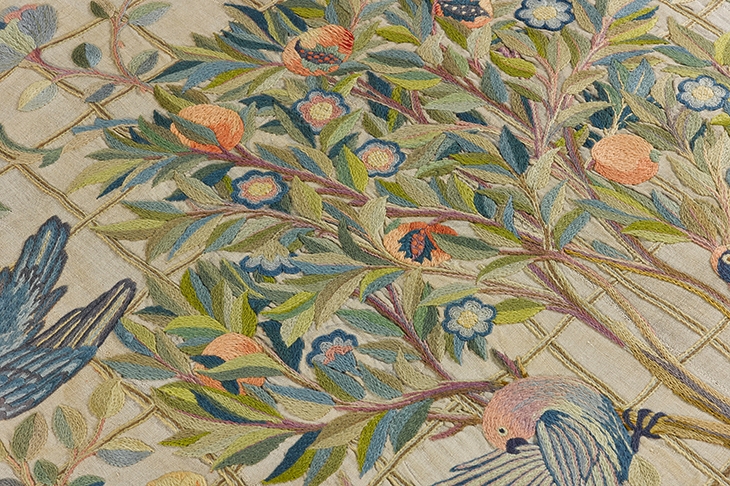You may think you don’t know May Morris, daughter of William, but you’ll probably have come across her wallpaper. Her honeysuckle design was and remains a Morris & Co. bestseller, and it not only features in homes to this day, it’s been nicked by designer Jonathan Anderson for a Morris-inspired range for the very expensive fashion house Loewe. It’s all a bit dispiriting for a woman whose aesthetic sensibility, like her father’s, was bound up in her socialism. But it was embroidery that was May Morris’s art and craft and now a new exhibition at the Morris Gallery in Walthamstow lets us see it in its own right.
The gist of May Morris: Art and Life is that her achievements were overshadowed by those of her celebrated father and were in any case overlooked because critics don’t rate needlework, not least because it’s mostly women’s work. But for William Morris and his firm, which revolutionised the way Brits furnished their homes, embroidery was an important element of its output and exemplified its guiding principles — beauty plus utility plus decent conditions for the worker. Her work deserves its own exhibition; as for her life, it merits more attention than it gets here.
As artist, May Morris was, unsurprisingly, a one-woman exemplar of the Morris philosophy. She learned art and design from her father and embroidery from her mother Jane and her aunt Bessie, a deaconess. So, from that apprenticeship she combined design work with its execution, and both with a very good grounding in the craft’s medieval precedents.
She studied at the precursor to the Royal College of Art in South Kensington, partly because of its access to the V&A and its splendid examples of Opus Anglicanum, the English needlework of the high middle ages (and the subject of a fabulous exhibition there last year). She taught the principles she practised at the Birmingham School of Art and was the author of an influential book, Decorative Needlework.
So, to cut to the chase, are we looking here at a feminist cause: a woman genius unfairly overlooked on account of her famous father and the womanly nature of her medium? A quote addressed to George Bernard Shaw, and reproduced here, says: ‘I’m a remarkable woman — always was, though none of you seemed to think so.’
Judging by the 80 works collected here (including her jewellery), May Morris was a significant figure of the arts and crafts movement, a designer of real skill, a fine colourist and an embroiderer of genuine creative artistry. But she wasn’t a genius, if that means originality of vision as well as supreme technical virtuosity (though I suppose it’s also a moot point whether her father was).
And if that sounds like faint praise, that’s because we undervalue needlework. At its highest point in the middle ages, embroidery was one medium among others, along with illuminated manuscripts and painted wooden panels, and as skilled as any of them, with much of it designed for liturgical functions. One of loveliest pieces in this exhibition, in fact, is the superfrontal May embroidered for an altar for aunt Bessie. (She was godless herself but you’d never think it from her work.)
Her work was beautiful. Take two panels that she designed and probably embroidered herself: ‘Spring and Summer’ and ‘Autumn and Winter’ (c.1895–1900). At the centre is a formal group of stylised roses, with two parakeets on either side, domestic birds above, and surmounted by roundels showing the fruits of each season. They’re full of life, but grounded in the medieval tradition, and a showcase of her skill: ‘laid and couched work, French knots, running, long and short stitches, back stitch, split stitch, satin stitch and stem stitch’. It’s her father’s aesthetic — but is there anything wrong with that?
Inevitably, given their closeness, it’s hard sometimes not to confuse the father’s and daughter’s work — though the beautiful cot quilt called ‘The Homestead and the Forest’ (c.1900), designed by May and executed by her mother Jane, was entirely distinctive, with a tranquil home in the enclosed garden at the centre, surrounded by wild and exotic beasts: very telling. May wasn’t just Pre-Raphaelite in her work; she was an incarnation of the house style — hardly surprising given that Jane Morris wasn’t just William Morris’s model but Rossetti’s too, as well as his lover. The circle was famously intertwined; as for the Socialist League, it was a roll call of the arts and crafts movement.
May’s profile was considered Grecian by some observers and in her youth that heaviness of feature was attractive; as an older woman, she looked lugubrious. It was in her prime that she had her affair with George Bernard Shaw — there’s a photograph of them here, with the husband she married on the rebound, Henry Halliday Sparling, and a charming Valentine she sent to GBS: ‘Even your very crochets form no bar to our affection’. Her marriage came unstuck when Shaw re-entered her life. Later she would have a relationship with the lawyer John Quinn, but you don’t get much of that here (though there are fascinating pictures of her companion in old age, a stout Cornish land girl, Mary Lobb).
To accompany the exhibition there is an excellent collection of essays, May Morris: Art & Life, edited by Lynn Hulse, and a lavishly illustrated companion book (not a catalogue), May Morris: Arts & Crafts Designer (Thames & Hudson/V&A, £24.95). But for all that, her most lasting legacy may be on the shelves of the exhibition: her edition of her father’s collected works in 24 volumes.







Comments